Why your pillow is ruining your sleep – and how to fix it

A general rule in life: if something seems too good to be true, it usually is. And in hindsight, the £10 I forked out for an anti-snoring pillow last summer would have been better spent on scratch cards. Still, it seemed like an opportunity too good to miss. A tiny price to pay to give my wife respite and to save me from sleep divorce.
Alas the Silent Night it promised never materialised and I am now frequently banished to the naughty room. The pillow meanwhile is in a landfill somewhere, along with countless others I imagine, purchased by people who were sold a dream. A mass grave full of broken sleep.
James Leinhardt sympathises. He is a sleep posture expert who advises chronically ill patients, athletes and the critically injured on sleep posture and runs Levitex, a mattress and pillow company.
“The industry is unregulated and some companies prey on the vulnerable. If you are in pain and can’t sleep, or your relationship is in trouble because of snoring and you’re then told of a pillow that will solve all your problems, you are an easy target,” he says.
Pillows with supposed magical properties are just the thin edge of the wedge. Walk into any bedding shop or look online for a pillow and the choices are endless. Big, fat, medium, small? Memory foam, natural fibres, micro-fibres, hypo-allergenic? Loft, density, weight? Where do you even start?
Good advice is a good starting point and Leinhardt, who has his own sleep posture consultation room, asks me about my sleeping habits. I explain that I usually begin the night on my side because I know I snore less in this position, but always roll over onto my back, usually because of discomfort. The snoring then begins and ends with the walk of shame in the early hours after my light-sleeper wife has finally managed to banish me.
“So, the ideal solution would be for you to have a pillow that keeps you on your side comfortably,” explains Leinhardt.
One of the main problems is that we tend to approach buying a pillow from the wrong perspective. Instead of asking whether it feels or looks nice, the real trick is to ask what you want it to do.
Positioning
Before you even contemplate buying a pillow, it helps to understand sleep anatomy. The holy grail of sleep is achieving a sustainable neutral spine position, as chartered physiotherapist and sleep expert Sammy Margo, the author of The Good Sleep Guide, explains.
“What we are aspiring to do is to keep the head and neck in the midline position which means a neutral spine position, not kinking your neck off to one side or the other as if you are holding a phone on your shoulder or bending too far forward or backward.”
It’s a pillow’s job to help you get into this position and stay there. Wrong pillow choice has implications.
“One typical example would be someone who sleeps on their back and has too many pillows and wakes up in the morning with headaches because their head is being bent too far forward,” continues Margo.
A good pillow should be comfortable but not at the price of support and not too firm. It should preserve a good sleep posture, and that will depend on the position you go to sleep in, because different sizes and types of pillows are better for different sleepers.
Side sleepers
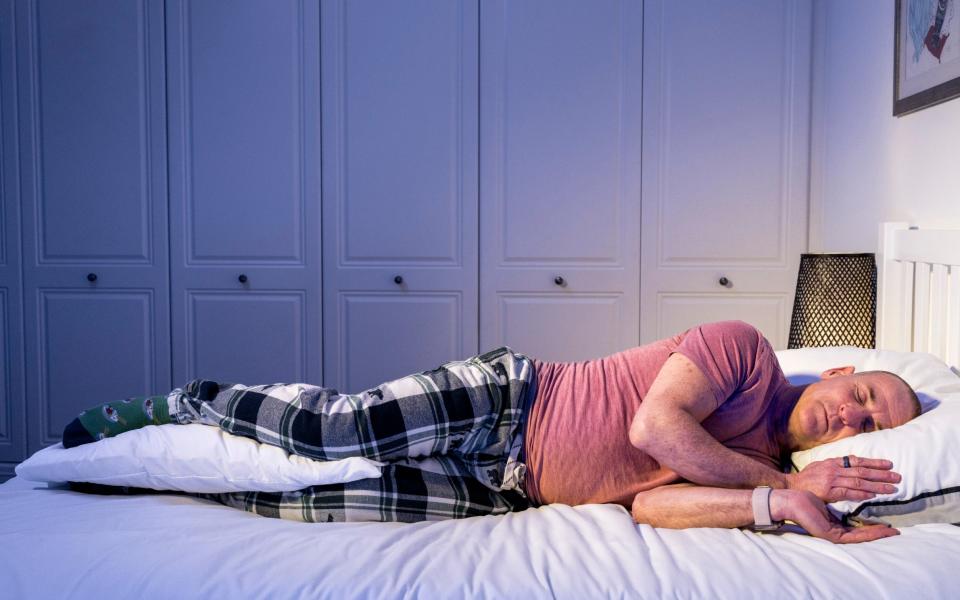
If you are a side sleeper (around 70 per cent of people are), when you lay down your pillow should fill the gap between the tip of your shoulder and the tip of your ear. This supports your head and keeps your spine in that important neutral position.
“For correct sleeping posture, only your head and neck should be placed over your pillow. Do not place your shoulders on the pillow because this will elevate your upper body higher than your lower body,” explains Margo.
If you are a side sleeper, you should choose a pillow that fills the gap and that also keeps your head in position. Many do not.
“If the pillow is too big you will strain your neck and if it’s too small your head will drop into the pillow,” explains Leinhardt.
The average head weighs between 4kg and 6kg (around 9-13lb), so your pillow needs to be dense enough to support that weight throughout the night, so your head doesn’t drop, which strains the neck.
“People who wake with shoulder pain usually do so because their pillow doesn’t support their head during the night,” adds Leinhardt.
Best pillow for side sleepers (as recommended by The Telegraph) – Simba Hybrid Firm Pillow.
Back sleepers
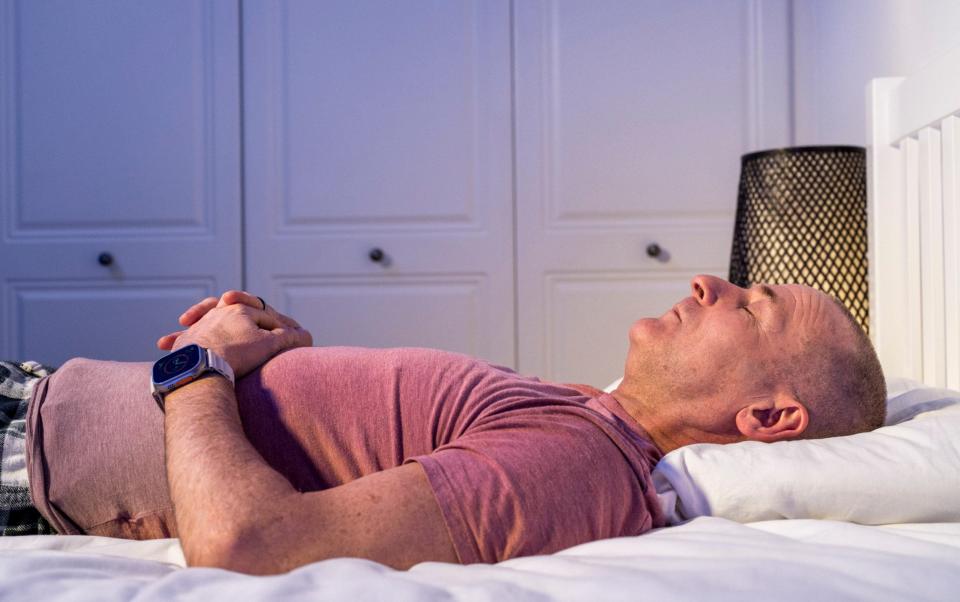
For back sleepers, a pillow should fill the space between the shoulders and the back of the head. This will invariably mean a thinner pillow than that of a side sleeper, as it is a smaller gap to fill.
While fewer people tend to sleep on their backs than on their sides, Margo explains that the position has a lot of advantages.
“It is symmetrical and as you get older you may need surgery and a large percentage of surgery requires you to sleep on your back. Provided you place a pillow under your knees to soften your lower back, it’s a good position to sleep in for a lot of ailments, such as hiatus hernia in elevation,” she explains.
Best pillow for back sleepers (as recommended by The Telegraph) – Emma Premium Microfibre Pillow.
Front sleepers
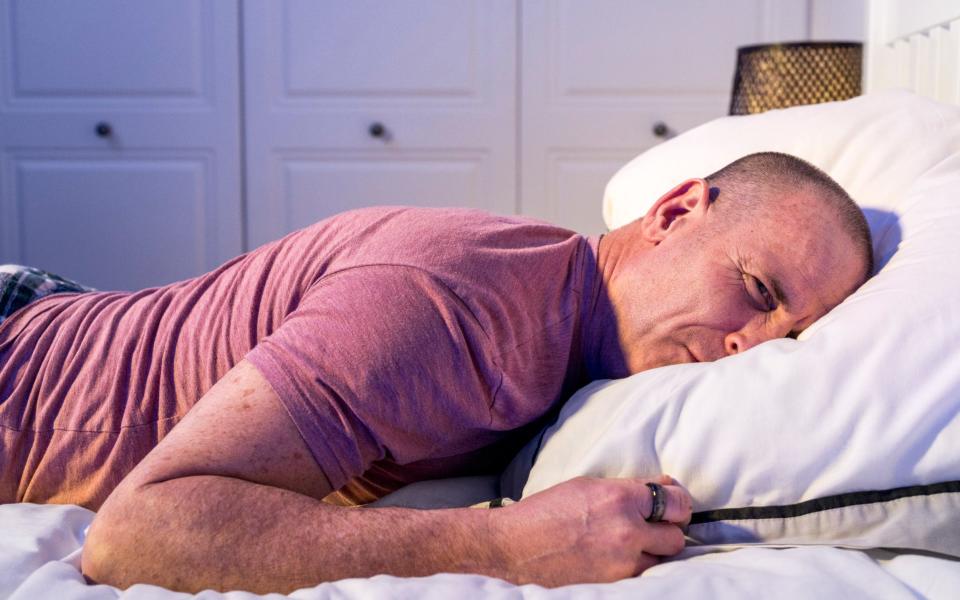
Leinhardt advises that front sleepers should “never buy a pillow, because you are already lying in a God-awful position”.
When you sleep on your stomach you must turn your head all the way to the left or right and if you have a pillow under your head, it will further extend the neck in an awkward position.
“Logic suggests this is not ideal,” adds Margo. “Your pillow should be relatively flat or removed. This will help keep your spine in line. In this position it is often best to place another relatively flat pillow under your stomach or chest to help natural alignment. If your mattress is soft, you may well need more than one. They will help minimise the strain on your lower back and the degree of twist in your neck.”
Best pillow for front sleepers (as recommended by The Telegraph) – Tempur Ombracio Memory Foam support pillow.
Body size
Your body dimensions will affect how effective your pillow is, particularly if you are a side sleeper. Margo recommends that pillow purchasers buy with an awareness of their anatomical dimensions.
“A pillow should fit like a glove,” she says. “Sometimes you can get a slim woman who has a wide neck. Sometimes you can get a big man who has a narrow neck. This affects the distance from your shoulder all the way up your neck. A good gauge is your clothes size and also your neck size. If you have a smaller neck, you might need a bigger pillow.”
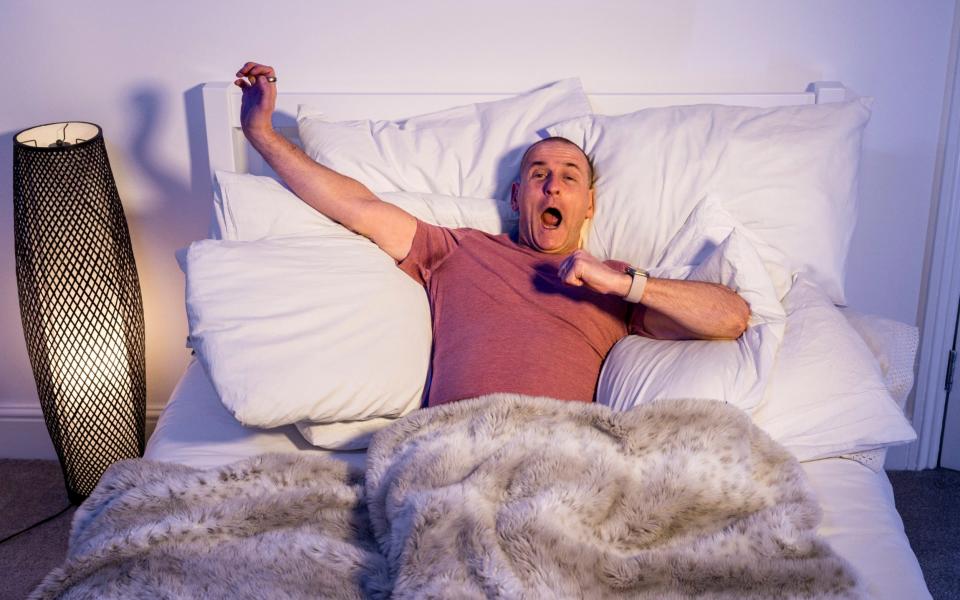
Material
Pillows come in a baffling range of materials and fillings. Choice is down to individual tastes, budget and needs. The most common fillings are:
Polyester
Some people may suffer allergies and so will best be served by a pillow with a man-made filling, which is mostly made from synthetic polyester. It is cheap and affordable, machine washable but not particularly durable and can clump together over time. There are other more exotic hypo-allergenic fillings including kapok, which is made from the fibre of the seeds of the kapok tree.
Down and feather
Down pillows are stuffed with the soft underfeathers from ducks and geese. They are durable and naturally soft. Down pillows have a luxurious feel and mould to the head and neck. They are often pricey and do not offer as much through-the-night support as more dense material.
Feather pillows are generally more affordable and use bigger feathers. According to Leinhardt: “If you don’t sink in enough, it will be like sleeping on a brick and if you sink in too much it will be like sleeping on a bowl of porridge. Feather and down feel comfortable and are culturally opulent, but they don’t have any form, so they move.
“If what’s under your head is not stable your head will move and if your head moves, your neck muscles have to be active. The principle of a pillow is that it’s meant to take the head out of the equation for the night.”
Down is also not ideal for humid or damp rooms as humidity causes down to lose its loft and its ability to insulate, so the pillow will quickly go flat and become less supportive.
Memory foam
Pressure-relieving and comfortable, memory foam also continues to sink when pressure is applied, so might be comfortable when you fall asleep but may not offer the required amount of support throughout the night. “It’s a bit Marmite and memory foam is quite expensive,” says Margo. “Some neck patients love it, and others say it aggravates their neck. There can also be an issue with smell and heat.”
Cotton
Another common filling, it is usually firmer than polyester, is odourless and is also less of a problem for those with allergies. It is not as durable as other fillings however and can also clump.
Specialist pillows
Anti-snoring
Beware of the claims some pillow manufacturers make, our experts warn. Pillows claiming to be anti-snoring don’t stop snoring per se. They are designed to reposition the head and neck to open the airways, but it is worth noting that 67 per cent of snorers will stop or reduce snoring simply by lying on their side, so it may be more advantageous to find a pillow that optimises sleep in a side sleeping position. If a pillow can keep you on your side, it will probably help reduce snoring.
“For some people they are effective, but so is sewing a tennis ball into the back of your pyjamas to keep you from laying on your back. It comes down to the physiology of snoring and the causes. If you are drunk, you are more likely to snore. So, it’s about understanding what’s causing it and changing the position to adjust to it.”
Cooling
Pillows with cooling technology, specifically marketed at women going through the menopause, should also be approached with caution. The small print will usually state the material is “cool to touch”. But it doesn’t stay cool throughout the night when a warm head and neck are resting on it.
Orthopaedic
The same cynicism should be applied to pillows that claim to be orthopaedic, as the term is often used in an undefinable way. “What does that even mean?” asks Lienhardt. “If a pillow claims to do something, the manufacturer should be able to validate those claims.”
Try before you buy
Given how individual a choice of pillow is, the sagest advice is to try before you commit to buying. And this shouldn’t be a quick squeeze in the bed shop. Try it for as long as possible. Is it still comfortable after five, 10 or even 15 minutes?
Many pillows now come with a trial period. Levitex customers, for example, have a 44-day trial period.
Margo also advises persisting with new pillows. “They can take a while to bed in. Don’t dismiss a pillow straight away,” she says.
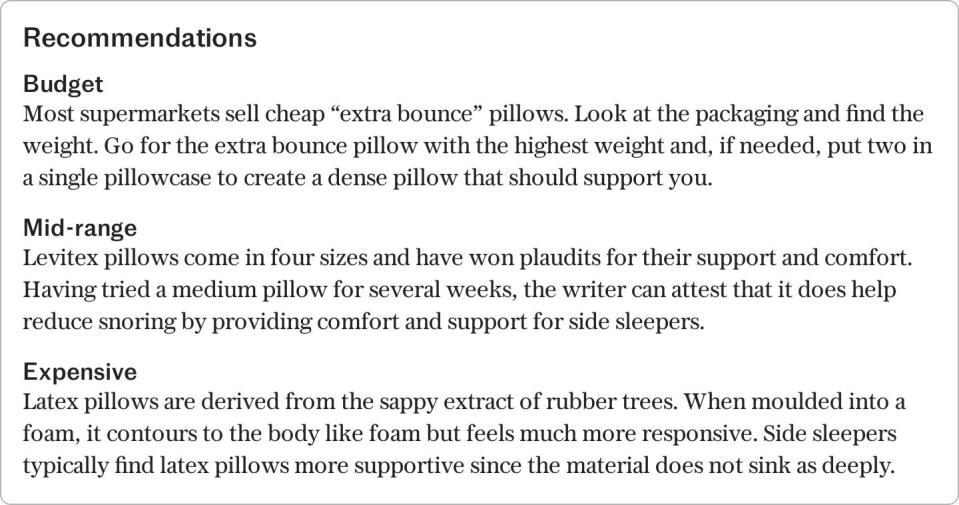
What to do if your pillow fails and you get a cricked neck
A cricked neck in the morning can be caused by sleeping position, too many pillows, not the correct type of pillow, or other sleep issues. Gentle stretching and self-massage can help loosen the muscles and ligaments in your neck that have become tight and stiff during the night sleeping. Gently tilt, bend and rotate your neck to loosen your neck muscles and regain full mobility.
Margo advises: “I call these easy neck exercises ‘yes, no, maybes’. Turn your head from side to side five times, look up and down five times and then alternate your ear to shoulder five times.”
In addition, while sitting upright, look straight ahead and hold your left shoulder down with your right hand. Slowly tilt your head to the right while holding your shoulder down. Repeat on the opposite side. Hold each stretch for five seconds and repeat three times on each side.
An ice pack applied to the affected area can also help reduce inflammation while alternate cold and heat can soothe and loosen tight muscles. A hot shower can also help.
For more persistent pain, over-the-counter pain medication such as Voltarol gel should help.
The NHS advises against wearing a neck collar as it’s better to keep your neck moving (unless directed otherwise by a doctor).
Recommended
How to use 'sleep maths' to get the perfect night's rest
